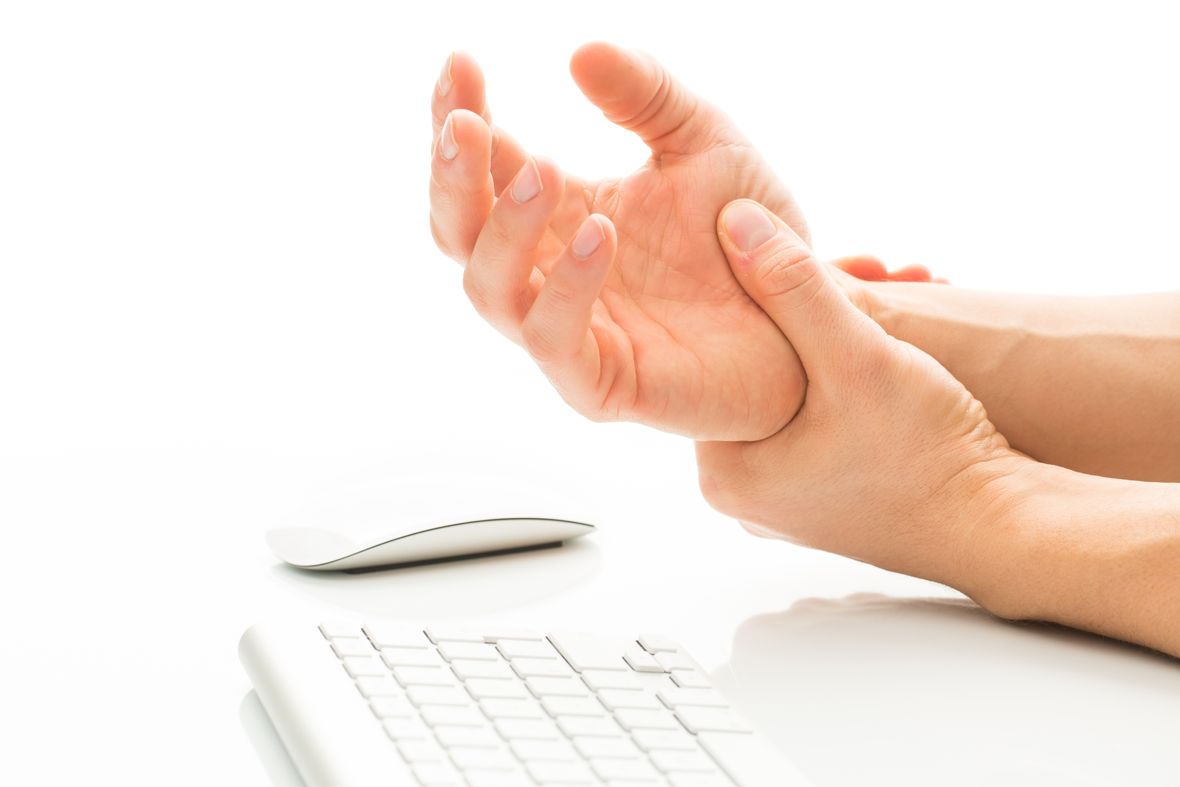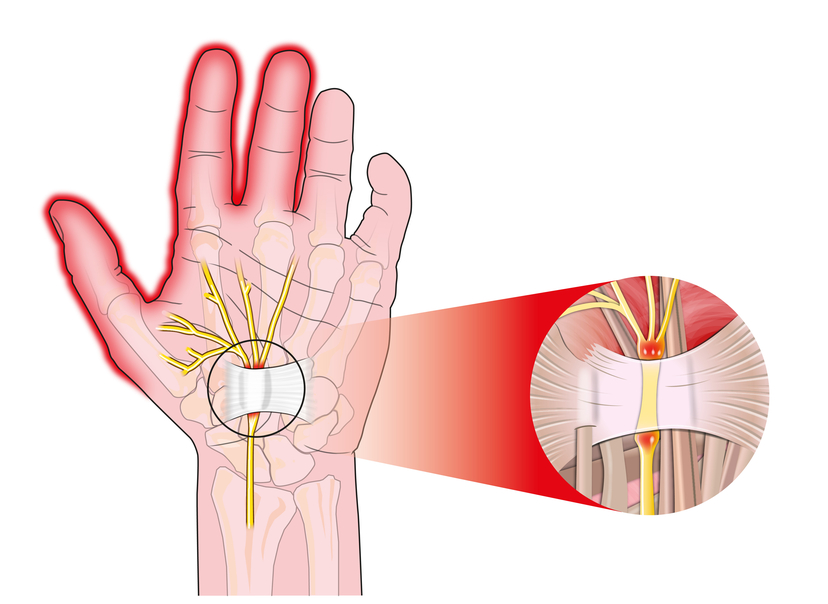If you regularly work with a computer, you’ve heard about carpal tunnel syndrome.
Maybe you know someone who had to go through surgery because of it.
Long hours at a keyboard can cause a lot of injuries, but the one most people seem to know about—and worry about—is carpal tunnel.
Could you be making mistakes today that increase your risk?
What is Carpal Tunnel Syndrome?
Google “carpal tunnel” and you’ll find all sorts of medical definitions about just what this thing is. We’re told to imagine a “tunnel-like” structure in the wrist surrounded by bones and covered by connective tissues called the “transverse carpal ligament.”
According to the American Academy of Orhthopaedic Surgeons (AAOS), there’s a big nerve called the “median nerve” that goes through this tunnel from the forearm into the hand. It controls feeling in part of the palm and fingers. Tendons that move the fingers also travel through this area.
It makes a little more sense when you can visualize it, so check this out:
- The white band you see here is the transverse carpal ligament.
- The yellow lines are the median nerve (and branches of that same nerve) going out into the hand and fingers.
- The area the nerve is traveling through is the tunnel-like structure.
What Causes Carpal Tunnel Pain?
The key to carpal tunnel syndrome is that yellow median nerve. Pain, tingling, numbness, and other typical symptoms occur because there’s pressure on that nerve, disrupting it.
In other words, this is a nerve problem, not a muscle problem—a key distinction to keep in mind, as sometimes you may feel pain in your hand that is muscle related.
The difference:
- muscle pain is usually dull and aching
- nerve pain is usually tingling or sharp
What causes this pressure on the nerve?
- Swelling from rheumatoid arthritis
- Wrist fracture that narrows the tunnel
- Fluid buildup around the nerve
- Thickening or swelling of the tendons around the tunnel
Symptoms usually begin slowly, and grow worse with time.
Some People Are At Greater Risk for Carpal Tunnel Syndrome
Many of us believe that carpal tunnel occurs only because of lifestyle factors (like typing too much), but the syndrome is actually more likely to occur because of inherited risks or other medical problems. People who have a higher risk of developing it include those who:
- Are born with a smaller “tunnel” than most
- Suffer a sprain or fracture to the wrist area
- Have rheumatoid arthritis
- Have hypothyroidism
- Have an overly active pituitary gland
- Suffer fluid retention because of menopause or pregnancy
- Develop a tumor or cyst in the tunnel area
- Are women—they are three times more likely than men to develop carpal tunnel
- Have diabetes
- Have family members with carpal tunnel
- Are obese (studies have shown obesity increases risk of carpal tunnel)
What are the Symptoms of Carpal Tunnel Syndrome?
If you suffer from the following symptoms for more than a couple weeks, you need to check with your doctor about potential carpal tunnel syndrome:
- Persistent pain, numbness, or tingling in the hand
- Pain or numbness that runs from the hand up the arm
- Itching or numbness in the thumb, index, and middle fingers
- Fingers that “feel” swollen even though they aren’t
- Weakness in the hand and/or fingers
- Symptoms that show up at night, causing sufferers to want to “shake them out”
- Decreased grip strength
- Difficulty grasping small objects
It’s critical that don’t delay in getting that doctor’s appointment.
Early treatments can prevent permanent damage to the nerve. If permanent damage takes place, it can affect your ability to feel hot and cold, and to continue to type and perform other similar tasks.
What are the Typical Treatments for Carpal Tunnel?
If your doctor diagnoses carpal tunnel syndrome, he or she will likely recommend treatment immediately. Options include:
- Splinting: A splint holds your wrist straight, and may be used particularly at night. This may be the best option if your syndrome is caused by fluid buildup at pregnancy, or might otherwise soon resolve on its own.
- Pain medications: Over the counter pain relievers can help relieve pain in the short term.
- Change of activities: Avoiding those activities that cause pain may allow the hand to heal over time.
- Steroids: Corticosteroid injections are helpful in some cases for reducing swelling and easing pain.
- Diuretics: For those with fluid buildup as the cause of their carpal tunnel, diuretics may help flush excess fluid from the body, thereby easing pain.
- Physical therapy: Stretching and strengthening exercises may be helpful for some people.
- Surgery: For those with symptoms that persist for six months or more, surgery may be the best option. The basic idea is to make the “tunnel” larger so it no longer puts pressure on the nerve. Most of the time, this is accomplished by cutting the carpal ligament. Symptoms usually go away quickly, but patients may experience some residual weakness in the wrist. The good news is that the pain usually stays away after surgery.
7 Ways You May Be Increasing Your Risk
As much as we hear about carpal tunnel, you’d think it happens all the time, but it’s actually not as common as you may think. According to the Centers for Disease Control and Prevention (CDC), about 3.1 percent of employed adults (18 to 64 years old) were diagnosed in 2010.
What may surprise you is that according to the American Chiropractic Association (ACA), those who work at the computer are not the most at risk for carpal tunnel. Instead, it’s those who work on the assembly line in manufacturing, sewing, finishing, cleaning, meatpacking, and other similar industries. Food cashiers have been found to be particularly at risk.
In fact, recent research shows that people who work on the computer up to seven hours a day are not at increased risk for the syndrome. Other studies show that it’s the other factors mentioned above—like diabetes, arthritis, etc.—that put people at risk more than workplace conditions.
Those who do have other risk factors, however—and also experience repetitive hand and finger strain—are likely to be increasing their odds of suffering pain.
Whether you are particularly at risk or not, it’s important to practice good habits just in case. If you find yourself doing any of the following, make changes immediately to protect your hands.
- Positioning your keyboard in the wrong place: To reduce strain on your wrist, you need to have your arms relaxed. Your keyboard rest just above your lap, so your arms tilt downward and your elbows are open.
- Raising the back of the keyboard: This is a big mistake. It positions your fingers to be higher on the top row of letters than at the bottom row, and forces your wrist into an unhealthy angle. A better position is actually the opposite—the keyboard tilted at a slightly negative angle, with the top slightly lower than the bottom. When in doubt about your keyboard, think “lower!”
- Using a regular mouse: Some studies suggest that using a regular mouse is more dangerous than typing. Try a trackball or track pad instead.
- Using a straight keyboard: A split keyboard or jointed-type keyboard may work best for you, particularly if you’re noticing the beginnings of tingling or pain. Early in my writing career, I started experiencing pain in my left hand. Looking back, I think it was muscle related, but switching to a split keyboard solved my problem. The design may also reduce your risk of carpal tunnel—it allows your hands to rest in a more natural position, putting less strain on your wrists.
- Failing to stretch your hands: I often stop in the middle of the day to stretch my hands. This helps counteract the tightening and shortening of the muscles and ligaments that can occur after hours of work—which in turn, can cause inflammation and potentially increase risk of carpal tunnel. Try pulling your fingers over the back of the top of your wrist and holding for about 10 seconds. Feels great! Another option: Make a loose right fist, palm up, and use the left hand to press gently down against the clenched hand. Resist the force with the closed right hand for 5 seconds. Be sure to keep the wrist straight.
- Failing to stop when you experience pain or numbness. We can become so focused on meeting deadlines that we push ourselves beyond our limits. If you feel pain, your body is telling you to stop. It’s best if you listen.
- Ignoring your overall health: Recent studies have discovered that other things— like diabetes, obesity, arthritis, and thyroid problems—may be more likely to increase your risk of carpal tunnel than too many hours spent at the computer. Don’t forget to take care of your overall health—eat a balanced diet, exercise regularly, manage your stress, and remember to take time off to relax at least once a week!
Do you worry about carpal tunnel syndrome? Have you made changes to prevent it? Please share your thoughts.



I have a problem with my rgiht hand. I sit in front of computer for long hours. From wrist to fingures, the hand is hot. If I put my hand in cold water, I get great relief. I don’t have any pain.
My left hand palm is more or less normal.
Could you tell me.. what disease I am facing and solution for this.
Thank you
Thank you for your comment. We can’t give out individual medical advice so please see your doctor. Long hours in front of the computer can be tough on your hands/arms—do try to get up and move more often, stretch, and give your hands a break. Good luck and hope you feel better soon.
My hand surgeon said to switch to a touch pad instead of a mouse…my question is how do I do that?
As far as I know, Pam, you can get separate touch pads to hook up to your computer. Depends on what kind of computer you have, but I’m sure you could talk to your local provider/repair shop or call a computer supply store to find one. There are a lot of them available.
Thank you–interesting and helpful!
Thanks for stopping by, Julie. Take care of those hands and wrists! :O)
Using a mouse a lot seems to trigger what symptoms I occasionally have, which are few and far between and may not be carpal tunnel-related. (Just numbness mostly.) An ergonomic mouse pad with a pillow-like “wrist rest” fixed that for me completely! I had been leaning my wrist on the edge of the table I work at, cutting off circulation to my hand. Not a good idea! But the ergonomic mouse pad is.
Yes, I’ve read that about mice–they tend to make things worse! (Both the living and non-living kinds!) Glad you found a solution. I love the trackball mouse because I can rest my hand on it and just move my thumb. Is that laziness talking? (ha) Seriously, it’s much more comfortable.